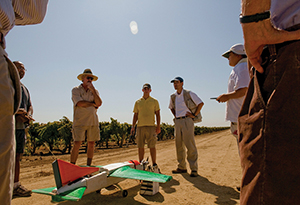On a Wing and a Prayer: Insects from the Sky to the Rescue
 |
|
Experimental aviation: Yong-Lak Park and his team conduct field research with a drone. Source: Yong-Lak Park, West Virginia University Entomology |
Yong-Lak Park, a professor of entomology at West Virginia University, says when it comes to drones, he’s just an end-user who pokes engineers for technology to use. But that doesn’t stop his dreams of flying: He wants drones to deploy natural enemies, not pesticides.
“I decided that detecting something was not enough,” he said. “What if we could detect and deliver good insects to counteract the bad ones?”
He conducts his research in a mountainous area of West Virginia—the entire state, he says, is 70 percent mountains. It typically takes five hours to hike any one of those mountains.
Big Mountains, Few Resources
Growers in the Mountain State do pest monitoring on a shoestring budget. Meanwhile, the Appalachian region suffers from invasive species like gypsy moth, emerald ash borer, southern aphid, brown marmorated stink bug, and insects from the south on the move due to changing environmental conditions.
The state’s location is important, tucked between the populous Midwest and East Coast.
“People ask, ‘Hey, can you survey West Virginia for emerald ash borer?’ I can’t do it on foot, but maybe it can be done with an unmanned aerial vehicle (UAV),” he said
Park presented his work in 2015 at the International IPM Symposium in a session organized by the Northeastern IPM Center. A video of his talk is available on the web.
Technology Advances
New developments in remote sensors and monitors are making it easier for scientists to detect subtle or pronounced changes on the earth’s surface. UAVs are increasingly able to cover large areas in a short period of time and reach hard-to-access areas. A small UAV can be put into a backpack, hiked, and flown. It’s also less tiring for the pilot and the entomologist.
Park began working on aerial delivery of predators in 2012. He designed a drop system, putting small insects in straws inside a specially designed capsule. They test dropped it from a tall building. They checked the bugs and they still had all six legs and two antennae. Furthermore, they could walk, feed, and mate. Aerial delivery didn’t hurt their biological functions. Currently, he is working on applying the concept to various agricultural ecosystems.
“Drones won’t be delivering natural enemies for pest management in the near future,” Park cautions. “However, drones can do what current pest management can't do—and what current pest management can do, drones can do it more efficiently, safely, and economically.”
It will take time before commercial and legal issues are worked out and deployment of beneficial insects from drones becomes a reality. It is currently illegal to drop any object from a drone in the United States. Park has a large-scale study in the wings, waiting for new FAA regulations and permits.
And with a little help from engineering friends, some good bugs—and one guy who dreams about them—are going to fly.
— by CHRIS GONZALES
The Northeastern IPM Center promotes integrated pest management for reducing risks to human health and the environment. If republishing our news, please acknowledge the source (“From Northeast IPM Insights”) along with a link to our website.
